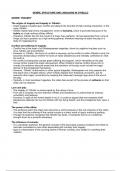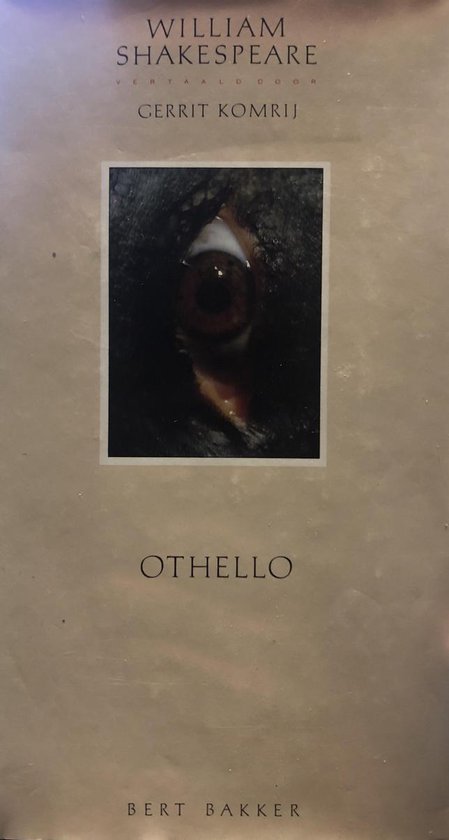GENRE, STRUCTURE AND LANGUAGE IN OTHELLO
GENRE: TRAGEDY
The origins of tragedy and tragedy in ‘Othello’:
• Greek tragedy is based upon con ict and depicts the downfall of high-ranking characters, in this
case, Othello.
• Othello makes fatal errors of judgement, which is hamartia, which is provoked because of his
hubris as a high ranking military o cial.
• Therefore, Othello ts into the mould of a tragic hero perfectly. He has descended from a line of
Kings and has a position as a high ranking general, therefore meaning he starts the play in a
state of megalopsychia.
Con ict and su ering in tragedy:
• Con ict lies at the heart of all Shakespearean tragedies, driven by negative impulses such as
envy, hatred, lust and ambition.
• However, in ‘Othello,’ the focus of con ict is narrower, as the con ict is within Othello’s mind. He
becomes divided about whether he loves or hates Desdemona and mentally con icted on what
the truth is.
• His con ict consequently causes great su ering and anguish, which intensi es as the play
moves further toward the tragic denouement. When Othello’s internal con ict drives him to
murder, the audience become aware that the resolution of the play must include the tragic
demise of the protagonist themselves.
• However, ‘Othello’ is alternative to other typical tragedies. Shakespeare not only presents the
rst black hero in English drama, which initially departs from theatrical convention, but he
subverts other tragic conventions by keeping the malevolent revenger Iago alive at the end of
the play.
• Typically, in most Jacobean tragedies, the villain dies as part of the process of catharsis so that
order can be restored.
Love and pity:
• The tragedy of ‘Othello’ is preoccupied by the nature of love.
• From act 3 onwards, the love between Othello and Desdemona is undermined by mistrust,
uncertainty and jealousy.
• However, in spite of the violent deaths in act 5, it could be argued that love reasserts itself.
Desdemona defends her love fro Othello with her dying breath, and the protagonist dies ‘upon a
kiss.’
The power of the villain:
• The audience watch the tragic hero becomes a victim because of the evil schemes of the villain:
it is clear that the su ering of the central couple is a direct result of Iago’s malicious plotting.
• Though the audience recognise that Othello has faults, it transpires that he is a nobleman
brought down by a powerful adversary.
The in uence of comedy:
• To a Jacobean audience, the general concept of the play being a jealous husband who feels he
has been cuckolded is more often associated with comedy than tragedy.
• Iago is a descendant of the cunning slaves of Roman comedy, who delight in outwitting their
masters.
fi flfl flfl ff fi ff flffi fl ff fl fl fi fl
, STRUCTURE: DRAMATIC
The use of setting:
• There is a narrow focus in ‘Othello’ which is depicted within the two principal settings of the
play: Venice and Cyprus.
• However, as the play progresses, as an audience we gradually see our attention becoming xed
to a single bedroom, thereby creating the feeling of claustrophobia.
• The outer world therefore becomes insigni cant as Othello becomes obsessed and jealous.
• The use of Venice as a location is signi cant because at the end of the 16th century, dramatists
began to use Italy as a suitable location for revenge tragedies. It is therefore appropriate that the
machiavellian, Iago, should originate and appear in an Italian setting before being transported to
Cyprus.
• The war islets Desdemona from everyone and everything she knows. In an unfamiliar setting
with the threat of danger lurking, order is destroyed.
• The storm helps to establish and re ect the fear and violence that the characters will experience
in Cyprus, whilst also serving as a symbol for the love of Othello and Desdemona.
The sense of claustrophobia:
• The sense of claustrophobia is emphasised by the fact that there is no subplot in Othello,
therefore meaning that the action of the play focuses on Iago’s role and Othello’s response.
• The single plot intensi es dramatic tension as we are never given a moments respite or
diversion from the intense drama whereby Iago is pushing Othello towards the tragic demise of
himself and other beloved characters.
• Sense of claustrophobia is heightened because as an audience, it is clear that we are observing
a group of characters who exist in a tightly knit social network in which Iago threatens the order
and harmony of such network.
THE TIMESCALE OF ‘OTHELLO’
The ‘double time scheme’:
• The theory of a double time scheme in ‘Othello’ arises through the inconsistencies within the
play.
• It appears that the disintegration of Othello’s mind and marriage occurs extremely fast and Iago
recognises that he must move quickly is his plots are to remain concealed.
• However, at the same time, the characters make statements that suggest time is moving slowly.
‘Long time’:
• ‘Long time’ in the play is suggested to have been primarily designed to increase the plausibility
of Othello’s jealousy.
• However, it is also necessary for Shakespeare to present the poisoning of Othello’s mind to be
occurring swiftly, without a substantial interval of time.
• The play would therefore be less dramatic if Iago loosened his grip on his victim once he was in
his grasp.
‘Short time’:
• The rst act of Othello takes place in one night. Simultaneously, when the characters arrive in
Cyprus, time seems to move very quickly which all increases the sense of claustrophobia and
heightens the intensity of the drama.
• It may be argued that the inconsistency of ‘short time’ is a deliberate theatrical decision;
Shakespeare perhaps uses this time scheme to convey how powerful and unreasonable
jealousy is as we know that Desdemona has not had the time or opportunity to commit adultery,
yet her husband becomes convinced that she has betrayed him often.
fi fi fl fi fi fi





